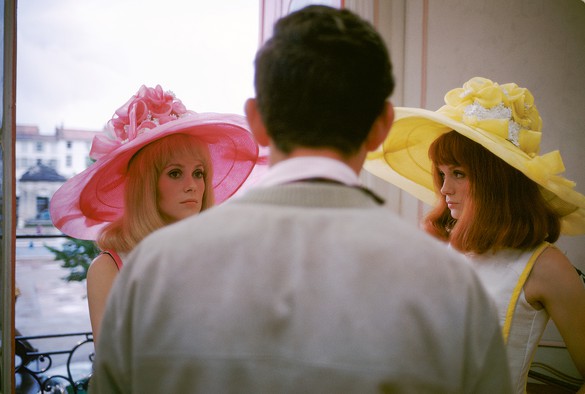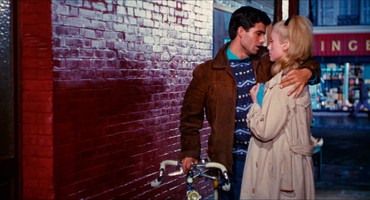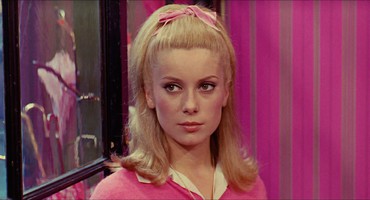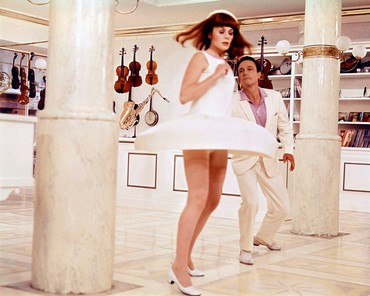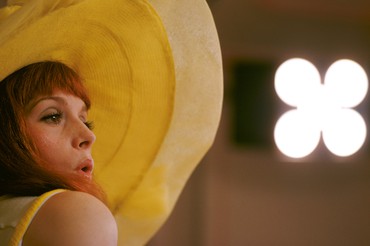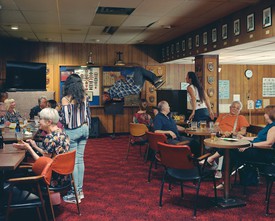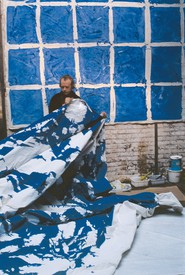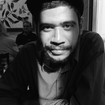
Carlos Valladares is a writer, critic, programmer, journalist, and video essayist from South Central Los Angeles, California. He studied film at Stanford University and began his PhD in History of Art and Film & Media Studies at Yale University in fall 2019. He has written for the San Francisco Chronicle, Film Comment, and the Criterion Collection. Photo: Jerry Schatzberg
Without love, pleasure’s inventions are soon exhausted. There must be a soul within the body you are holding, a soul which you are striving to meet, a soul which is striving to meet yours.
—James Baldwin, Just above My Head, 1979
Although by and large people were asleep or had gone home, Agathon, Aristophanes, and Socrates were still awake, all by themselves. . . . Socrates was carrying on a conversation with them. Aristodemus said he couldn’t remember most of the discussion, . . . but the nub of it was that Socrates was trying to get them to agree that knowing how to compose comedies and knowing how to compose tragedies must combine in a single person, and that a professional tragic playwright was also a professional comic playwright.
—Plato, Symposium, c. 385–70 bce
The cinema’s most enthusiastic lover, Jacques Demy, poured all of himself into a single moving shot in The Umbrellas of Cherbourg (1964). We are in the coastal city of Cherbourg, 1957. Geneviève (Catherine Deneuve), the blonde daughter of an upper-middle-class umbrella-shop owner (Anne Vernon), has just been told by Guy (Nino Castelnuovo), her dark-skinned prole mechanic boyfriend who smells of gasoline all day, that France has drafted him to fight its terrorizing war in Algeria, for reasons neither will ever understand. In a stream of mournful song (no words are spoken in this film opera), they fill each other up with youthful promises: I will wait for you, I will keep faithful to a present we cannot see, a future that can never hold. Suddenly Demy launches into an extraordinary traveling shot: as if by centrifugal force (or is it Cupidinal?), Guy hugs Geneviève, his yellow bike pulling forward without the need to steer or pump the pedals. It’s an extraordinary shot for its blatant artifice. Even Demy had his doubts when he reflected back on the making of Cherbourg, saying that this movement, crafted in homage to his cinematic idol Jean Cocteau, went a step too far.
Not to protest the master, but I must. Here, illogic and sensation are piqued by a rejection of friction. The traces of this space-deforming force can be glimpsed in the shifting of colors as the camera tracks the lovers deeper and deeper toward their eventual destiny in bed: from the brick reds of impersonal Cherbourg streets, past an unstable palette of green doors, pink shutters, and bitter lemons in a crate, until we rest in an alleyway’s faded blue, the working-class hues by which Guy is constantly identified. (His bedroom, where the couple will make love for the only time, has been plastered over by Demy and production designer Bernard Evein in the blue a primary-school boy uses to tell his story by the color jeans he wears.) As the two let themselves be pulled toward their fate—sex, departure, war, pregnancy, the forgetting of the obscure object of desire—out tumbles their entire love story, what they dread will occur (and does): “I’m so afraid when I’m alone.” “We’ll be reunited, stronger than before.” “You’ll meet other women, you’ll forget me.” “I’ll love you to my dying day.” They think what they’ve dreamed is unique, that war exists only insofar as their self-sustaining love will allow it to invade. In fact, they will find themselves alienated from the world around them. Guy will return from the Algerian War hobbled, a husk of his former smiling self, yet a peace-craving class-climber all the same, and none the wiser. Crippled, he will fill up gas at an Esso station as if the job were the culmination of all he is capable of. (And maybe it is.) He will pretend that he is his own owner, not Charles de Gaulle, not the CEO of Esso, not the CIA. He will run the station with a woman (Ellen Farner) who will resign herself to the truth that, at the end of the day, she unconditionally loves a married friend who regards her silently as a substitute, however filling. He will still love his old flame to his dying day—even when she will have married someone else, will be bejeweled and coiffed like the doll of the child that sprang from that single night of passion, the strongest of either of their lives.
This story is a happily ever after.
Life is a Jacques Demy musical. I began to cohere as a soul when I saw The Umbrellas of Cherbourg on a shitty DVD in the basement of the campus library, my freshman year of college. Since then, the lights from that screening have never gone up. I learned French just so I could eye-lick the wallpaper and absorb Demy’s dialogue in rhyming alexandrines without the distraction of subtitles. In senior year I began to fall into love, a roulette wheel circling dangerously round in a winning streak as hot as Bay of Angels (1963); in New York and New Haven, I crashed out of it—bed drunk, dazed, and frozen into a static blob, like the pathetic Roland Cassard (Marc Michel) in Lola (1961). Now I drift in a state of worry and barely concealed rage, but with glazed memories of Santa Monica sunlight, almost as if I were driving nonstop up and down the hazy Sunset Strip of Model Shop (1969), a cozy meander.
All the while, the forces that the stealth existentialist Demy saw as givens—a romanticism all but abandoned by postwar French capital, chance encounters that mingle freedom and doom in a single flash, a fate that doesn’t discriminate among identities—are always bearing down on me, even as I push them back. Those forces will linger. As Vincent van Gogh saw, and Maurice Pialat after him, “La tristesse durera toujours.”1 It is not the artist’s sadness so much as the sadness he sees around him that lasts. In this, Demy’s world is suffused with rose-tinted melancholia, which makes the militant of love want to wallow in bed until she dies, giving up the whole game altogether. Those attuned to the Demyian vision do not—really, they cannot.
Demy was born on June 5, 1931, in the village of Pontchâteau, near Nantes in western France. He and his family lived in a home that doubled as a garage, a family business that his father, Raymond, expected his son to take over when he was of age. But Jacques had no such plans. His mother, Milou, was a hairdresser (a role Demy’s favorite actress, Deneuve, would play in 1973’s A Slightly Pregnant Man) who also pulled the gas pumps, and who would take the precocious Jacques to local puppet shows. He became obsessed with learning the secrets of how the shows were assembled. At home, with wood sets and dolls in ratty clothes, the young Jacques would stage marionette versions of his most beloved fairy tales for his friends.2 Milou would also treat Jacques to sojourns at the Théâtre Graslin, absorbing operas such as Bizet’s Carmen. The Allied bombing of Nantes on September 16, 1943, ruptured the otherwise happy tranquility of his childhood. The family spent the entire event huddled in a shelter, leaving the young Jacques traumatized. “When something so dreadful has happened,” Demy says in his fellow filmmaker and lifelong wife Agnès Varda’s film The World according to Jacques Demy (1995), “you think that nothing more awful can happen. From that point, therefore, you dream up another, more ideal existence.”
That ideal existence would ultimately lead to the magnum opuses of the mid-1960s, the Umbrellas of Cherbourg/Young Girls of Rochefort suite of candy-colored musicals. (I don’t like to think of them as separate films, but rather part one and part two, 1964 and 1967, yin and yang, of the same project of epic emotion.) The ideal dreamers in these remixes of classical Hollywood musicals by Stanley Donen and Vincente Minnelli are glassy-eyed romantics in search of uplift, whether at the Cherbourg opera house playing Carmen or the plein air french-fry cafés in Rochefort’s place Colbert.
Undoubtedly, the Rochefort romantic with whom I most vibe is Françoise Dorléac’s pragmatic composer Solange. Say the name softly to yourself: Solange, so-la, two steps up a musical flight to the climax of the implied ti-do. Dorléac, whom her sister Deneuve (two years younger) insisted was the better actor of the two, is always bursting into a room in fits of fab glamour, commanding any space (café, music shop, street) into which she stalks or sulks but never merely walks. This flâneuse loves a sneak attack, the idle waiting that switches to impulsive action in those aforementioned bursts—a groundswell of Michel Legrand’s arpeggios, the casually sublime high kicks as she leans over a café counter to kiss the cheek of Maman (Danielle Darrieux) or to inquire about the new beau of Sis (Deneuve)—and then back to normal, back to being a member of a harmonized ensemble, the family in triple harmony. Amid the madness of a carnival in town, the soldiers on display, an axe murderer on the loose, Solange just towers and makes art out of her life (which is made for music). With her millisecond-long shrugs, husky voice, the readjusting tuck of her lavender dress as she takes her place at the piano stool to toss off another sonata, the flâneuse whispers to the boys and girls who pass her by: Why strain yourself, darlings. The lips never break.
Yet even in sunlight, clouds roll in. On June 26, 1967, a few months after production wrapped on The Young Girls of Rochefort, Dorléac, twenty-five, was rushing to the Nice airport; she needed to go to London to finish shooting her scenes for Ken Russell’s Billion Dollar Brain. Afraid of missing her flight, speeding irregularly, she lost control of the car she drove and hit a signpost. The car burst into flames. Her body was charred beyond recognition. Knowing that and rewatching The Young Girls of Rochefort, the postmortem sublimity of her ballet with Gene Kelly becomes horrifying, unsettling. It would be the apotheosis of anybody’s life to dance with Kelly, but it’s all the eerier that it was Dorléac, whose instinct for the unheralded gesture already made her a prime candidate for a nose-to-the-ground, ordinary woman made extraordinary, nearly immortal at the apex of joy. Even without knowledge of her eventual fate, it’s written in her being. There is a bleak, cosmic, Demyian irony at work in the fact that Deneuve could not watch The Young Girls of Rochefort for years after finishing it—and still cannot really return to it. The happiest movie in the world is nothing but sadness for its star.
Demy had the keen ability to attract this manic depression in whatever coastal town he washed up in: not just Rochefort or Cherbourg but also Nantes, Nice, and—in his one trip to the States—Los Angeles. His rendering of this latter American city has personal significance for me: my childhood memory of the city of angels is tied to a single image at the skittering periphery of Model Shop, in which Demy is just as obsessed as I was at ten with the oil rigs that drill into the coastal outskirts of the city. These sad flamingos pump a dismal patch of Venetian ground—a silent soundtrack to lives whizzing by on the freeway, cars filled with rowdy kids turning the corner into a lot festered with moss, the sad, gray-skied Manhattan Beach.
Somehow, Demy saw beneath this unpromising terrain and unearthed it in its perpetual act of becoming, never solidifying into oil or money, a sea of undead birds neither bland nor holy. Once again, he recycled his pet tracking shot (first seen in his 1959 short Ars and repeated in Lola and Bay of Angels)—this time, along a forgotten road in Venice upon which has settled the blanket of 1960s LA smog, a seldom imagined city in neither Hollywood sight nor Bel Air mind. The image is stark, laying bare the poor dreamer’s conundrum (how to maintain the dream in the face of stasis, failure, and death) in a stylistic register that can only be properly identified as “Angeleno neorealism.” Los Angeles pushed Demy to radically simplify his language.3 No storefronts are painted over. Legrandian strings are replaced by the hungover hippie dawdling of Spirit. Here, the sullen Angelenos still pine the way they do in France, but it’s a pining rendered with neither passion nor depth, by players (Alexandra Hay of Skidoo, Gary Lockwood of 2001: A Space Odyssey) who are terminally incapable of relaxing, and who talk as if they were glued beneath the proscenium arch of Hollywood High School.4 Yet from this reduction comes an expanded sense of daily melancholy: men who have been drafted to fight in Vietnam and realize they leave nothing behind, women who ride the winds of America in search of novelistic danger only to find banal sex everywhere they drive.
Demy’s movies are built on a simple premise: we have no idea along what cruelly random byway life will lead us. Rochefort is where Demy’s great obsession, the chance encounter, blooms in all its insanity. Is it by seconds that I will miss the one I love, the person with whom I’m meant to chart the sounds of the city in double harmony? Will anyone even notice the art I’m trying to make, the voice I’m projecting as far and clear as I can? Do I stay in my hometown, do I move on to greener (maybe grayer) city pastures?
If you see me walking down the streets of the East Village on the first day of spring, headphones in, bouncing like a sugared-up schoolkid, I’ll most likely be listening to Legrand’s score to The Young Girls of Rochefort. This is the only apt cinematic soundtrack for a city brimming with manic chance encounters as you turn the corner, a city whose very grid system is open to the contaminations brought on by le grand jazz. It’s my personal tribute to the one work of art in which, when I saw it on the big screen for the first time, I felt the space of the screen and the space of my seat collapse into one. I wasn’t high, I can’t explain the sensation, and it will never repeat. All I can do is listen to the song of the sailor Maxence (“Je ne connais rien d’elle, et pourtant je la vois”; I know nothing of her, and yet I see her) as we enjoy a black-and-white egg cream outside Ray’s Candy Store. At that point, I’m home.
Jacques, je t’aime—what a pity we could only meet through your films—and what a joy.
1According to Vincent van Gogh’s brother Theo, “La tristesse durera toujours” were the artist’s dying words. Maurice Pialat quoted them in his film À nos amours (1983).
2These memories are beautifully fictionalized in Jacquot de Nantes (1991), made by Jacques Demy’s wife, Agnès Varda, while he was dying of aids-related complications—a fact not publicly disclosed until her 2008 film The Beaches of Agnès.
3Demy struggled to speak English and hired the still underappreciated American screenwriter Carole Eastman (Puzzle of a Downfall Child, Five Easy Pieces, The Shooting) to write dialogue for him.
4Certainly the relaxed Harrison Ford, Demy’s first choice before the studios forced him to choose the then-better-known Gary Lockwood, would have given the role of George Matthews a smoother vibe. But Lockwood’s unease and stilted demeanor strike me as perfect for the character, a man whose imminent draft has made him nihilistically lose all shred of hope for a future, any future, in which he’s happy, in love, and alive.
